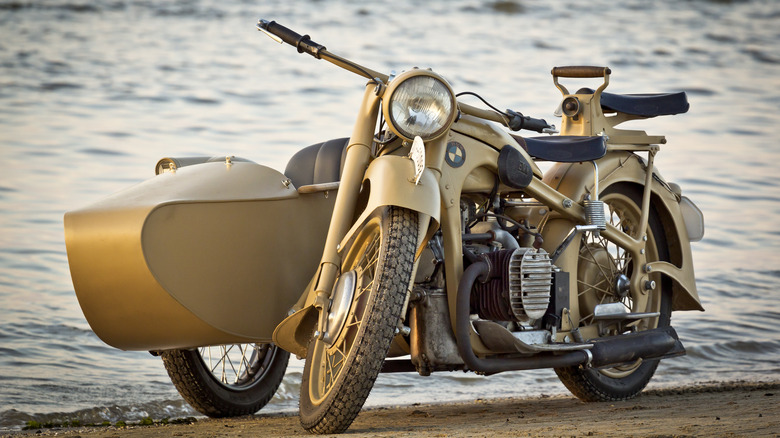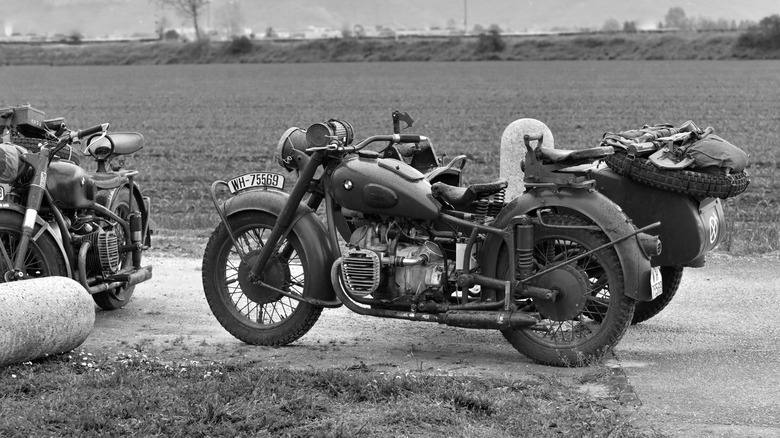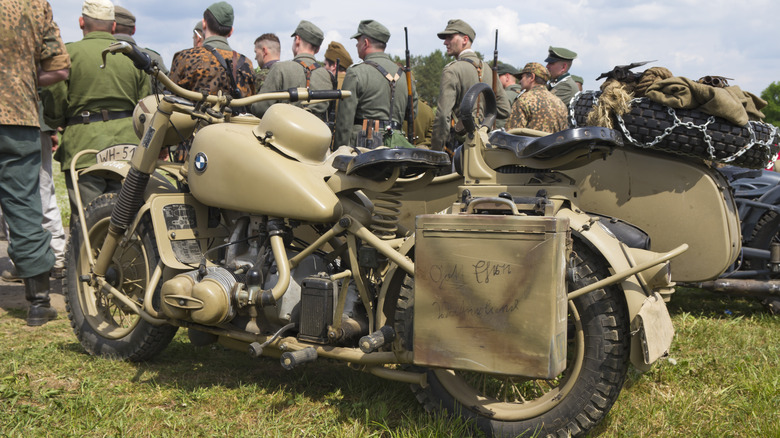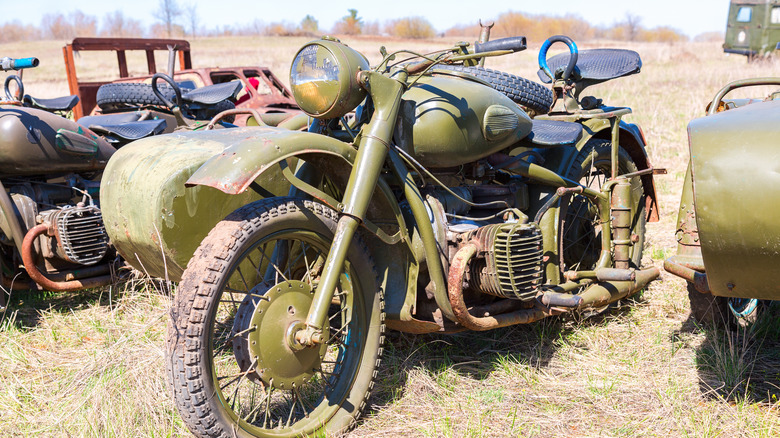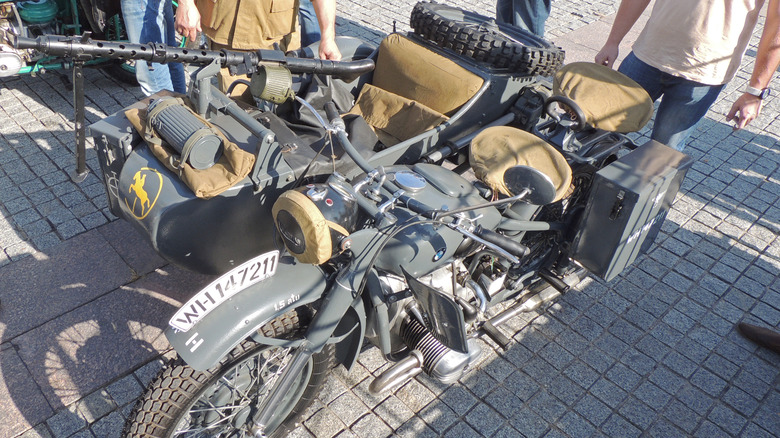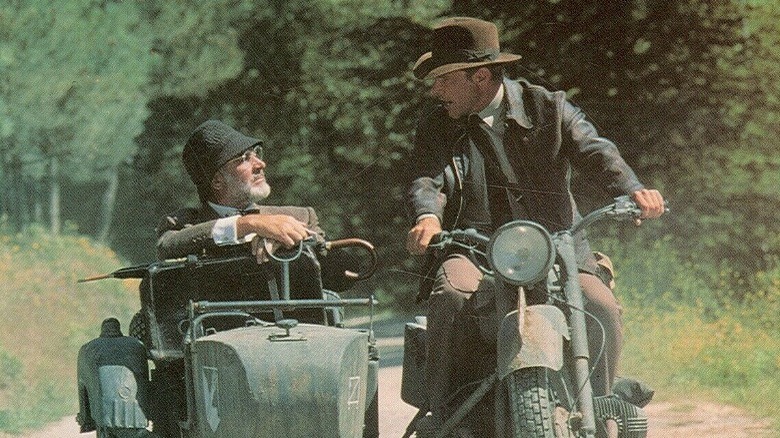The History Behind One Of WW2s Most Famous Motorcycles: The BMW R75
BMW has been around for over a century. The company has long since established itself as one of the most influential entities in just about every corner of the automotive industry, though some people may not realize that it's been making motorcycles for nearly as long as its doors have been open. To this day, BMW Motorrad is considered one of the best motorcycle manufacturers in the world. It makes everything from touring and adventure motorcycles that are meant for traversing the untamed wilderness to street bikes, cruisers, and roadsters that are built to maximize performance on the pavement. But to understand where the company is now, it's worth taking a look at one of the most famous bikes in its history: The BWM R75.
This heavy military bike was made during World War 2 to operate with a sidecar and navigate the rugged terrain that German soldiers would have to navigate across war-torn Europe and Africa. MCS referred to it as "Germany's equivalent to the American Jeep," in reference to its popularity as a mode of transportation among soldiers on the front lines. Its unique design and influence have made it a popular model among collectors. Here's a bit about the motorcycle itself and how it earned its place in automotive history.
BMW's history with Nazi Germany
To understand the BMW R75's place in history, you first have to understand BMW's history with the Nazi party. The company's involvement in WW2 certainly isn't the proudest moment in its history. BMW was founded in 1916, under the veil of WW1, but it's undeniable that it saw significant growth during the following World War when BMW manufactured and sold cars, planes, and even motorcycles that were exclusively designed for use by the German military. Not only that, but it did this using forced labor from German prison camps.
"Under the National Socialist regime of the 1930s and 40s, BMW AG operated exclusively as a supplier to the German arms industry," company representatives stated as part of BMW's 2016 apology for its involvement in the war. "As demand for BMW aero engines increased, forced [laborers], convicts, and prisoners from concentration camps were recruited to assist with manufacturing them. To this day, the enormous suffering this caused and the fate of many forced [laborers] remains a matter of the most profound regret," the company continued. BMW began development on the original R75 in 1938, and it was in production from 1941 to 1944 (though more non-German variants may have been produced afterward), meaning that it was being used by German soldiers for nearly the entire length of the war.
What design features did the BMW R75 have?
A lot of things stand out when you look at the R75's design. Every inch of it appears to have been designed for utility. The bike is a heavy, solid-looking vehicle that keeps both the rider and their passenger low to the ground while still providing shock support. It has thick, well-treaded tires, and nearly every piece of the backend seems designed to hold ample storage. Both the bike and its sidecar have the ability to store a spare tire, and the back storage on the bike itself can be used as an extra seat if necessary.
The German military had several requirements that BMW had to meet in order for the R75 to serve as a frontline vehicle. They needed the bike to have 4.5"x16" tires so they could be interchangeable. The military required the bike to have a 217-mile range on a single tank of gas, as its rider would often be expected to make long journeys without the opportunity to refuel. It also needed to be able to carry a lot of weight. The Germans wanted the bike that could transport three soldiers, each loaded down with gear. On top of all that, the bike also needed to be able to run on very low-quality gas, it needed to hit close to 60 mph, and it also needed to be able to run at a low enough speed that it wouldn't outpace footsoldiers without overheating — a tricky proposition in the days before liquid cooling.
What kind of performance did the BMW R75 offer?
So what was driving this heavy steel frame, loaded down as it was with passengers and gear? The BMW R75 had a 745cc, air-cooled engine. It got up to 26 horsepower and had a compression ratio of 5.8:1. It had twin cylinders with two valves apiece, and its induction system was managed by two separate carburetors. Most modern cruiser riders probably wouldn't think much of a 745 cc engine powering a bike that heavy, but keep in mind that speed and acceleration weren't BMW's primary objectives. The R75 was more of a pack mule than a racehorse. It needed a sturdy output of power that could reliably go long miles with irregular fuel supplies. Even so, it did manage to reach the 60 MPH top speed that the German military required.
The way the drive shaft connected to the sidecar was also quite unique. A shaft connected the engine to both the rear wheel and a secondary shaft, which ran to the sidecar — meaning that both the motorcycle's rear wheel and the parallel sidecar wheel were fully powered. This is how the R75 was able to achieve high levels of propulsion with such a wide stance without being off balance. The sidecar itself had fully powered rotation when connected, effectively turning the R75 into a rear wheel drive trike.
What was the BMW R75 used for during WW2?
So why did the Germans need a motorcycle like this? Riding sidecar in a warzone doesn't really seem like the safest mode of transportation. Why use a motorcycle at all when four-wheeled vehicles offer so much more protection?
"While advancing across Europe, the Wehrmacht recognized the need for a small and quick vehicle capable of negotiating various terrain," states HistoryNet. "In response, Bavarian Motor Works (BMW) introduced the R75, a three-wheel motorcycle and sidecar combination that was fast, maneuverable, and capable of handling rough conditions." This makes sense given the nature of WW2. Boarders shifted by hundreds of miles and the military needed to be sure that its vehicles would be able to handle whatever terrain was thrown at it — including those that larger vehicles might not have been able to navigate.
Germany attempted to get BMW and its competitor Zündapp to standardize their parts in 1942. This would mean easier production since factories owned by both companies would be producing the same parts, and it would make it easier to set up lines of distribution and stock inventory for field repairs across multiple vehicles. BMW agreed to the plan, but it never came about. American bombers took out BMW's Eisenach manufacturing facility before it started converting its parts. The attack took place on August 16, 1944. Six B-17s from the American 91st Bomb Group fell in under a minute during the assault. Even so, they managed to badly damage the primary facility responsible for R75 production.
The BMW R75's lasting influence
The R75 didn't just have a massive influence during the war; it has also had a lasting cultural influence as well. The bike has made an appearance in several films. An R75 appeared in the 1954 film "Betrayed." Steve McQueen was meant to be riding an R75 during the 1963 film "The Great Escape," (though it was actually a 1961 Triumph TR6 Trophy that was modified to look like an R75), and remember that scene in "Indiana Jones and the Last Crusade" where Indie and his father escaped Castle Brunwald on a stolen Nazi motorcycle with a sidecar? That was an R75 as well.
The BMW R75 was the first of its kind, but it was hardly the last. The post-war R51/3, R67, and R68 all made use of the same OHV flat-twin engine, and echoes of the R75's design can be seen in several bikes that were manufactured in the decades since. You can see its lineage in the American Harley Davidson XA and Indian 841, as well as the Soviet Dnepr M-72.
In fact, BMW brought the R75 model designation back in the form of the R75/5, which ran from 1969-1973, and then in the R75/6 which ran from 1973-1974. Several other bikes that didn't take the name outright have still manifested elements of the heavy, utilitarian design that the R75 established. Even new BMW bikes have drawn inspiration from the legacy of this wartime motorcycle, like the 2023 R NineT, which some consider to be one of the best BMW motorcycles ever made.
